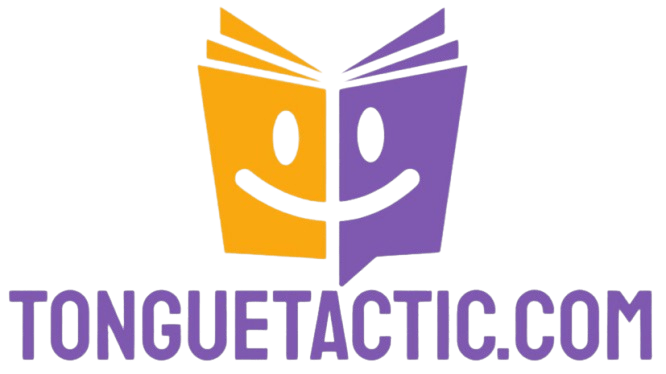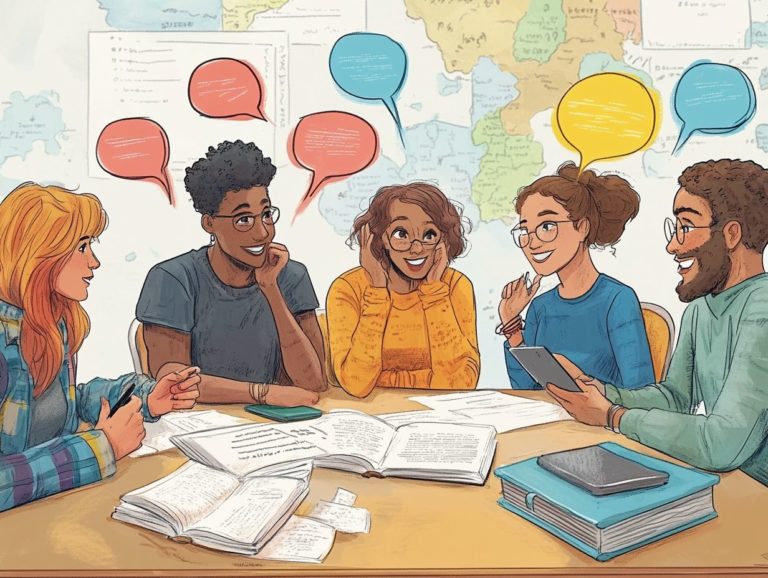top resources for learning sign language
Learning sign language unlocks a vibrant world of communication and connection, bridging the divide between hearing and deaf communities.
Whether you’re just starting out or aiming to refine your skills, a wealth of resources is available to guide your journey. You can explore an array of options from online courses and mobile apps to community classes and captivating YouTube videos.
Each of these resources brings unique advantages, allowing you to practice and immerse yourself in the rich culture that sign language embodies.
Unlock amazing tools that will make your sign language journey not just effective but fun! Don t wait start exploring today!
Contents
- Key Takeaways:
- 1. Online Courses
- 2. Mobile Apps
- 3. YouTube Videos
- 4. Community Classes
- 5. Private Tutors
- 6. Books and Workbooks
- 7. Sign Language Dictionaries
- 8. Online Forums and Communities
- 9. Deaf Culture Events and Workshops
- 10. Interactive Websites
- 11. Podcasts
- 12. Online Quizzes and Games
- 13. Sign Language Meetup Groups
- 14. Sign Language Television Programs
- 15. Sign Language Interpreting Services
- What Are the Benefits of Learning Sign Language?
- Frequently Asked Questions
- What are the top resources for learning sign language?
- Are online courses effective for learning sign language?
- Can I learn sign language from a sign language dictionary?
- Want to know the best way to practice sign language?
- Are there any free resources for learning sign language?
- Can I become fluent in sign language by using these top resources?
Key Takeaways:
- Expand your sign language skills with online courses, mobile apps, and YouTube videos.
- Immerse yourself in the deaf community by attending classes, hiring a private tutor, or joining events and workshops.
- Enhance your learning with books, dictionaries, podcasts, quizzes, and interactive websites.
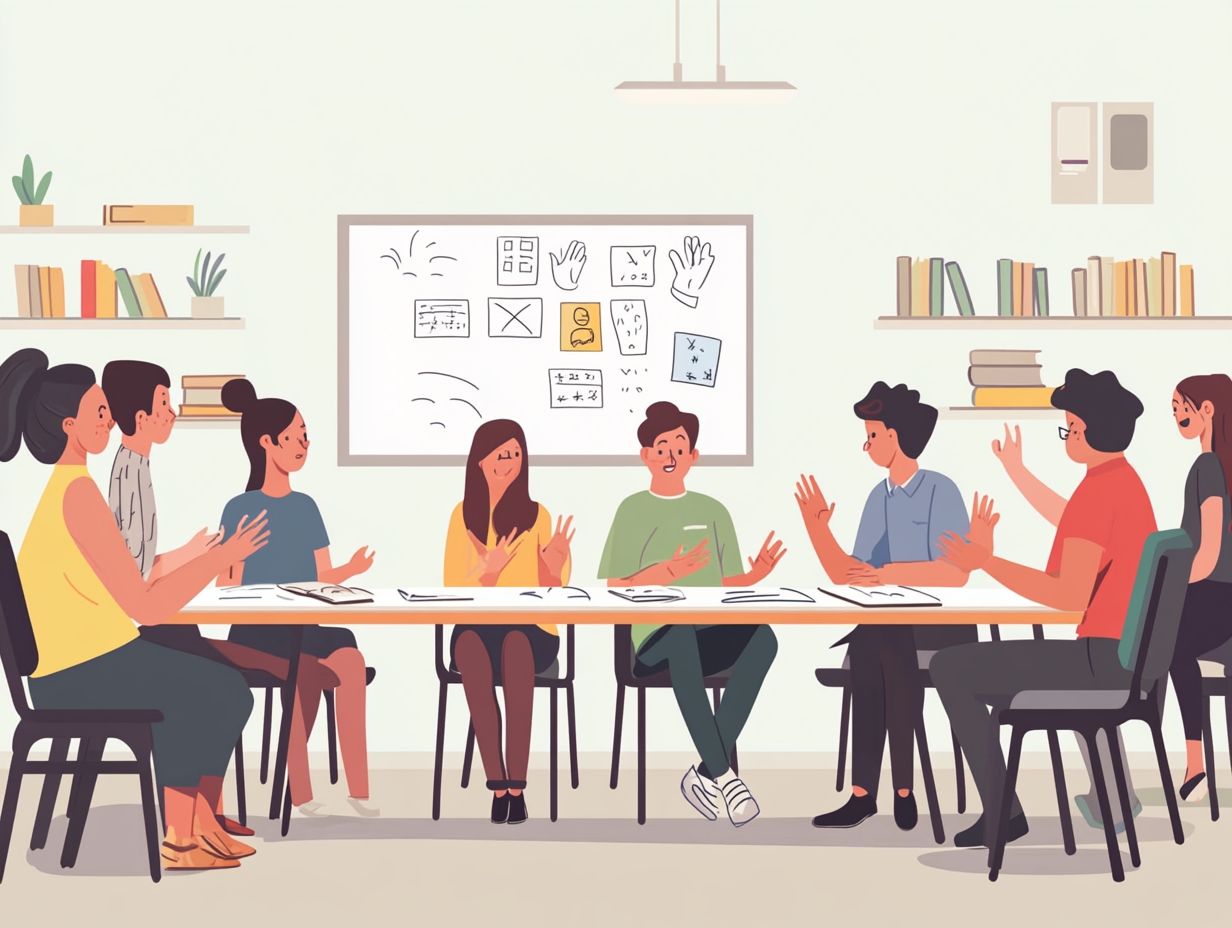
1. Online Courses
Online courses have emerged as an essential gateway for those eager to learn sign language, particularly American Sign Language (ASL). They offer flexible learning opportunities and a wealth of resources tailored to every skill level.
For those just beginning, the importance of ASL courses cannot be overstated. They establish the foundation for effective communication with the deaf and hard-of-hearing communities.
Many renowned online platforms boast comprehensive instruction, featuring lessons that teach not just basic vocabulary but also delve into the rich cultural aspects of sign language. With interactive elements like quizzes and video demonstrations, you can engage more actively with the material.
Instructors, often certified professionals in the field, bring invaluable expertise to the table, ensuring you receive a high-quality education. Community engagement fosters a supportive learning environment, allowing you to share experiences, practice skills, and encourage one another throughout your journey.
2. Mobile Apps
Mobile apps have transformed the way you learn sign language, especially American Sign Language (ASL), providing you with flexibility for on-the-go practice and interactive learning experiences.
With applications like ASL Connect and the ASL App at your fingertips, you can immerse yourself in fingerspelling drills (which is spelling out words using the fingers of one hand), vocabulary expansion, and honing effective communication skills all from the comfort of your smartphone.
These apps offer fun ASL tutorials, games, and quizzes. This makes learning enjoyable and effective.
The platforms are equipped with user-friendly interfaces that cater to all proficiency levels. You ll find valuable resources perfectly tailored to your needs, whether you re just starting or looking to refine your skills.
The interactive quizzes not only reinforce your knowledge but also keep you motivated as you track your progress. With gamified elements like challenges and rewards, the learning process becomes dynamic and engaging.
Video tutorials provide the visual context necessary for comprehension, bridging the gap between theory and practice. These apps create a supportive learning environment that encourages you to confidently embark on your sign language journey.
3. YouTube Videos
YouTube is an invaluable resource for anyone keen on mastering sign language, offering a treasure trove of videos that span from basic ASL tutorials to captivating interactive stories.
These videos, crafted by experienced ASL instructors and renowned influencers like Marlee Matlin, help you grasp the intricacies of American Sign Language, including regional signs and essential vocabulary.
Dedicated ASL education channels create a space for community engagement, allowing you to practice your skills and receive constructive feedback.
With various formats ranging from vocabulary lists to conversation practice and cultural insights you can customize your viewing experience to align with your personal learning style.
Popular channels feature beginner-friendly playlists as well as advanced lessons designed to enhance fluency. The visual nature of sign language makes YouTube an ideal platform for showcasing intricate movements and expressions, deepening your understanding.
By diving into comment sections and collaborating with others, you can share tips, ask questions, and immerse yourself in the vibrant sign language community, elevating your overall learning journey.
4. Community Classes
Community classes, often hosted by local community colleges, play a crucial role in delivering accessible American Sign Language (ASL) education for individuals like you, eager to connect with the deaf community.
These classes cater to various levels, including beginner ASL. This allows you to progress at your own pace while receiving personalized instruction from qualified ASL instructors.
These community classes foster an inclusive environment where you can engage in conversation practice and sharpen your communication skills. This supportive setting enhances your learning and offers invaluable opportunities for social interaction with peers who share your interests.
By collaborating with local deaf organizations, these classes often bring real-world experiences into the mix. They feature guest speakers and community events, creating a rich tapestry of cultural exchange.
You ll gain insights into deaf culture and participate in activities that promote awareness and inclusivity. These interactions spark lasting friendships and connections that can truly enrich your life!
Start your journey today by enrolling in a community class that suits your needs!
5. Private Tutors
Private tutors provide a bespoke approach to learning American Sign Language (ASL). This allows you to receive tailored instruction that aligns perfectly with your unique learning style.
In one-on-one sessions, you can focus on the areas that interest you or where you need help, making it an incredibly effective way to enhance your communication skills within the deaf community.
Seasoned ASL instructors bring their expertise and cultural insights to the table, enriching your learning journey. Whether you re a child just starting to explore ASL or an adult aiming to refine your conversational skills, private tutoring can significantly elevate your understanding and proficiency.
The advantages of personalized lessons go beyond mere content. They cultivate confidence as tutors adapt their teaching techniques based on your individual progress and preferences.
When seeking qualified ASL instructors, it’s crucial to look for professionals with relevant certifications and experience in diverse learning environments. During your sessions, you can anticipate a vibrant atmosphere where you engage in interactive activities, receive constructive feedback, and develop a deeper appreciation for the language and the culture that surrounds it.
Take the first step by finding a private tutor who resonates with your learning style!
6. Books and Workbooks
Books and workbooks serve as essential companions for anyone eager to deepen their understanding of American Sign Language (ASL). They offer structured learning paths and comprehensive vocabulary resources that guide you through the intricacies of the language.
Whether you’re starting with beginner materials or looking into advanced grammar, these resources include printable charts and exercises that enable hands-on practice with signs and fingerspelling.
Many ASL books also weave in cultural insights, helping you appreciate the rich heritage of the deaf community. For learners at various proficiency levels, a wealth of choices awaits you.
Novice learners can engage with interactive workbooks that focus on everyday dialogue and foundational vocabulary. Meanwhile, advanced students will benefit from comprehensive texts that cover nuanced grammar and professional signing techniques.
Integrating these materials with multimedia methods like videos, tutoring, or online courses will enhance your retention and practical application of the language. Notably, you should explore renowned titles such as:
- ‘Signing Naturally’ by Ella Mae Lentz
- ‘The American Sign Language Phrase Book’ by Lou Fant
Both of these gems offer invaluable insights into the language and culture, enriching your learning experience. Start exploring these resources today to enhance your ASL journey!
7. Sign Language Dictionaries
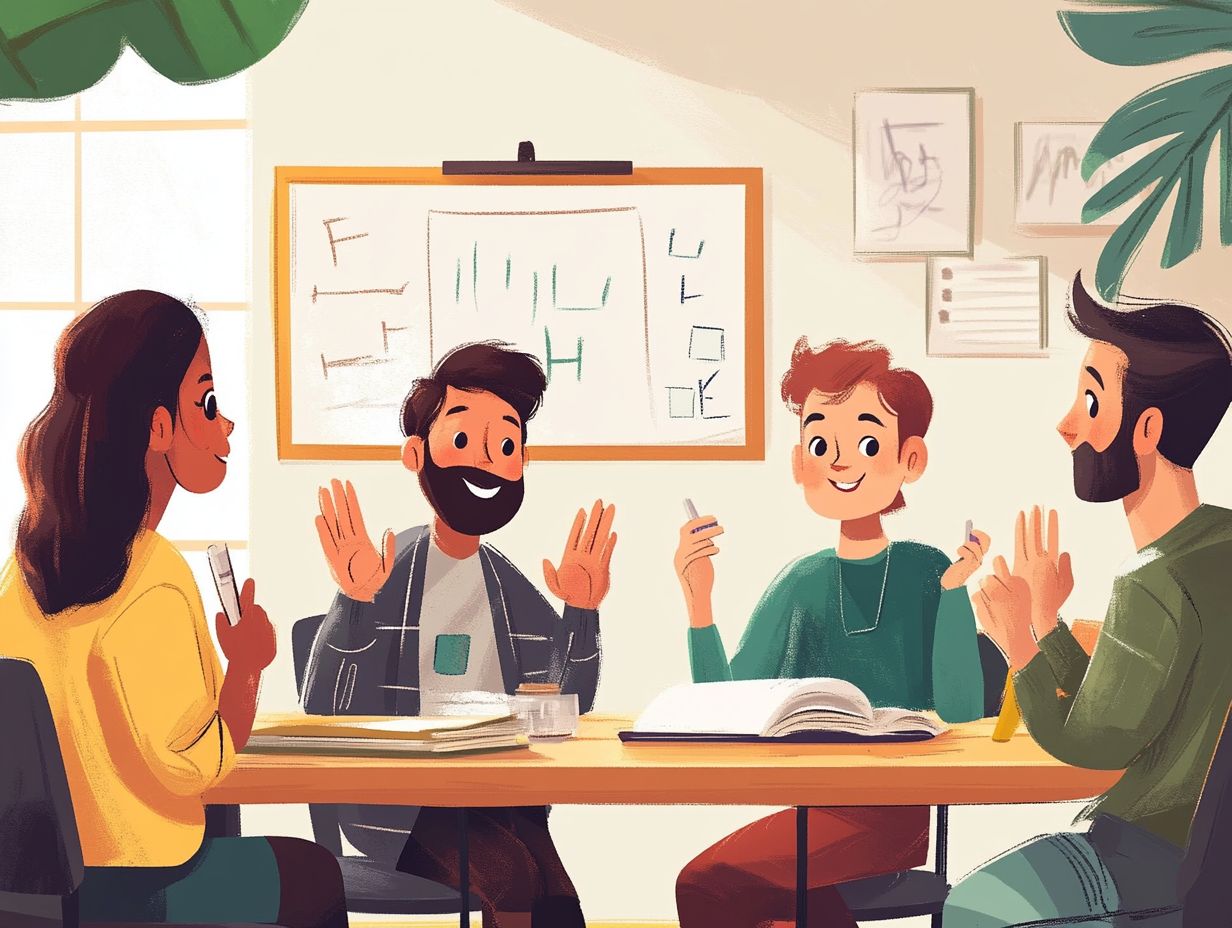
An ASL dictionary is a valuable resource for learners of American Sign Language. It serves as a comprehensive guide to common signs and fingerspelling, which is the method of spelling out words using hand signs.
These dictionaries include visual representations of signs and contextual examples to enhance your understanding.
They are essential tools for beginners and advanced learners alike. This ensures that you can reference signs accurately as you learn.
Using a good ASL dictionary alongside other resources like apps and instructional videos enriches your vocabulary acquisition. This multifaceted approach helps you build a strong foundation in the language and internalize signs more naturally.
These dictionaries are vital for clear communication, allowing you to clarify meanings and ensure your messages are conveyed accurately.
When searching for reputable ASL dictionaries, consider platforms like Signing Savvy and ASL Pro for extensive collections. Additionally, online resources like Lifeprint provide valuable lessons and community support for learners at all levels.
8. Online Forums and Communities
Online forums and communities focused on sign language learning create a supportive space for you to share experiences, ask questions, and engage with fellow learners and instructors.
These platforms spark discussions about effective communication skills, regional signs, and early intervention strategies. This helps you feel a sense of belonging within the wider sign language community.
Through these interactions, you gain valuable insights and encouragement to enhance your ASL skills. Joining these forums gives you great peer support and the chance to share resources.
Whether you’re connecting with dedicated platforms like Reddit s r/ASL or Facebook groups for ASL enthusiasts, these spaces allow you to exchange materials, practice through video chats, and share tips and tricks.
Many forums even host live Q&A sessions with experienced ASL instructors. These sessions offer unique learning opportunities that deepen your understanding of complex concepts.
Ultimately, being part of these vibrant communities enriches your learning experience and cultivates lasting friendships with like-minded individuals.
Join a forum today and start connecting with fellow learners!
9. Deaf Culture Events and Workshops
Deaf culture events and workshops provide immersive experiences that deepen your understanding of American Sign Language (ASL) while celebrating the rich heritage of the deaf community. These gatherings let you connect and practice your ASL skills!
Attending these events fosters a sense of belonging and equips you with practical skills that boost your confidence in using ASL effectively.
From captivating storytelling sessions to hands-on workshops focused on deaf history, each event presents unique avenues for personal growth and understanding. Be sure to seek out local meetups or workshops that resonate with your interests!
To make the most of your experience, prepare ahead by familiarizing yourself with the event s agenda. Reaching out to organizers for any specific requirements can greatly enhance your journey.
10. Interactive Websites
Interactive websites designed for learning sign language offer an exceptional platform for acquiring American Sign Language (ASL) skills in a dynamic and engaging way. These sites typically include a variety of resources like videos, quizzes, and games tailored to different learning styles and levels.
With a structured curriculum at your fingertips, you can progress through ASL courses at your own pace. This setup helps you build a solid foundation in sign language.
The inclusion of videos and animations makes the learning process enjoyable and significantly boosts its effectiveness. You get to visualize signs and their contexts through recorded demonstrations, which can solidify your understanding.
A user-friendly interface makes navigation easy, even for beginners. This minimizes frustration and enhances your overall experience.
Popular platforms like ASL Pro and SignSchool offer comprehensive learning journeys. They come complete with community forums and instructor feedback that beautifully complement traditional resources such as textbooks and personal tutoring.
This multifaceted approach enriches your learning experience, addressing a range of educational needs and making your journey toward mastering ASL all the more rewarding.
11. Podcasts
Dive into the world of ASL with exciting podcasts! Podcasts focused on American Sign Language (ASL) and deaf culture provide a groundbreaking way to immerse yourself in the language while gaining valuable cultural insights.
These podcasts cover ASL grammar and vocabulary while sharing real stories from the deaf community. By tuning in to native signers and educators, you can significantly enhance your comprehension and appreciation of ASL as a visual language.
The flexibility of podcasts allows you to learn at your own pace, transforming commutes, workouts, or household chores into fruitful learning experiences. Unlike traditional classrooms, these audio lessons fit into your multitasking lifestyle, enabling you to engage with ASL content while managing other tasks.
Popular choices in this realm include:
- “ASL That!”
- “DeafCast”
These options cater to various interests, from foundational sign language skills to deeper cultural contexts. By incorporating these podcasts into your routine, you can cultivate a richer understanding of both the language and its culture, making your learning experience more dynamic and enjoyable.
12. Online Quizzes and Games
Online quizzes and games present an engaging method for you to learn sign language, allowing you to reinforce your ASL skills while enjoying the process.
These tools often feature practice quizzes that challenge your vocabulary knowledge and comprehension, along with captivating sign language games for learners of all ages.
By weaving play into your learning experience, you can boost your confidence and deepen your grasp of American Sign Language. Beyond vocabulary quizzes, you’ll find interactive challenges designed for you to practice fingerspelling (spelling out words using hand signs) and sentence formation in a lively manner.
Many platforms offer timed quizzes that encourage quick thinking and bolster memory retention. These educational resources can fit seamlessly into your regular study routine consider using them as a warm-up before diving into more intensive practice or as a relaxing activity after a study session.
By actively engaging with these interactive tools, you can enrich your learning journey and make significant strides in your ASL proficiency.
13. Sign Language Meetup Groups
Sign language meetup groups create an inviting atmosphere for you to practice your skills and connect with others. These gatherings are a fantastic way to immerse yourself in the ASL (American Sign Language) community. They provide a great chance to apply what you’ve learned in a supportive environment.
Whether organized by local deaf organizations or informal groups, these meetups are invaluable for building your confidence and engaging with fellow enthusiasts who share your passion for learning ASL.
By actively participating in these meetups, you not only deepen your understanding of the language but also gain essential exposure to the cultural nuances that accompany it. Don’t wait! Find your local groups today; a quick search on social media platforms or community boards will reveal many advertised gatherings.
Regularly joining these groups enhances your skills through consistent practice while fostering friendships that enrich your overall learning journey. The social interactions and real-world applications offered by these meetups become important parts of mastering ASL, transforming theory into meaningful communication.
14. Sign Language Television Programs
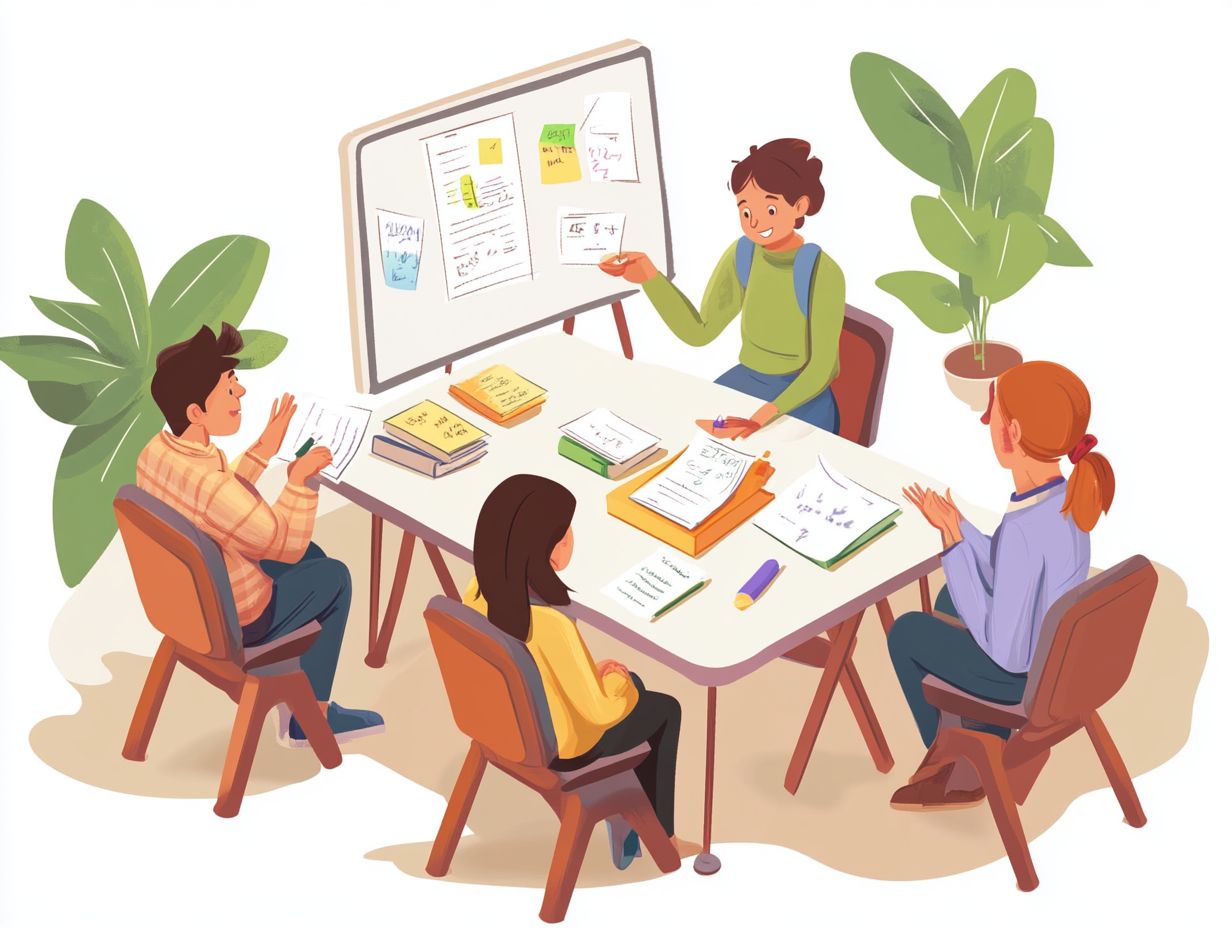
Sign language television programs present a captivating way for you to immerse yourself in American Sign Language (ASL) while also exploring the vibrant facets of deaf culture and community.
These programs often feature engaging conversations, storytelling, and educational content delivered in ASL, which enhances your comprehension and visual language skills. By blending entertainment with education, these sign language shows offer you a delightful opportunity to reinforce your ASL knowledge.
These programs also explore rich traditions and narratives within the deaf community, making them essential for fostering cultural appreciation.
Channels like DeafTV and ASLized provide a variety of content, from animated series to informative documentaries. Shows like “ASL Nook” captivate audiences with interactive lessons.
By tuning into these programs, you not only sharpen your signing skills but also gain valuable insights into the values, challenges, and accomplishments of deaf individuals, enriching your overall learning experience. Start watching sign language programs now to boost your learning!
15. Sign Language Interpreting Services
Sign language interpreting services are essential for facilitating effective communication between the deaf and hearing communities. They ensure you can access vital information and engage fully in society.
ASL interpreters provide crucial support in diverse settings, from educational environments to public events. This cultivates an inclusive atmosphere that honors deaf culture and fosters understanding. The availability of these interpreting services is critical for nurturing meaningful connections and enhancing deaf education.
In medical contexts, interpreters bridge critical communication gaps between patients and healthcare providers. This is vital for obtaining accurate diagnoses and crafting effective treatment plans.
In the workplace, professional interpreters promote active participation in meetings and training sessions. This ensures that you, as a deaf employee, have the same opportunities as your hearing colleagues. It’s important for interpreters to be fluent in ASL and possess an understanding of cultural nuances and specialized training in various fields.
Ultimately, the work of these professionals profoundly affects community accessibility, leading to greater participation and enablement of deaf individuals across all aspects of life. Join the movement towards inclusion and support interpreting services today!
What Are the Benefits of Learning Sign Language?
Learning sign language, especially American Sign Language (ASL), presents a wealth of benefits. These go far beyond simply communicating with the deaf community.
This vibrant language can supercharge your communication skills and sharpen your thinking skills. It cultivates a deeper appreciation for diverse cultures.
As you immerse yourself in ASL culture, you develop empathy and inclusivity. This forges connections that enrich both your personal and professional life.
Mastering sign language stimulates mental agility. Your brain becomes adept at processing visual cues and spatial awareness, significantly boosting your problem-solving skills.
Socially, you’ll become more attuned to non-verbal communication. This not only improves your interactions with deaf individuals but also helps bridge gaps within diverse groups.
On an emotional level, the friendships and support networks you cultivate within the deaf community can be transformative. They foster a profound sense of belonging.
Embrace this rich language today! It opens doors to deeper conversations and broadens your worldview, promoting harmony across communities.
How Can Sign Language Be Used in Different Settings?
Sign language can be a powerful tool in various settings. From educational environments to social interactions, it allows you to communicate effectively with members of the deaf community.
In schools, workplaces, or public events, mastering ASL fosters inclusivity and enhances your interpersonal relationships. Understanding the contexts in which sign language is used helps you appreciate its significance in bridging communication gaps.
In schools, incorporating ASL greatly enriches the learning experience for deaf and hard-of-hearing students. It ensures they engage fully in discussions and extracurricular activities.
In hospitals, skilled interpreters facilitate crucial conversations between patients and medical staff. This guarantees accurate diagnoses and essential care.
Community events, such as cultural festivals, thrive with ASL usage. They promote a vibrant exchange of ideas and cultivate a sense of belonging among diverse groups.
By championing effective communication in these settings, ASL creates an inclusive environment where everyone feels valued and understood.
What Are the Different Types of Sign Language?
You ll discover a fascinating array of sign languages worldwide. American Sign Language (ASL) stands out as one of the most recognized forms of visual communication in the United States.
Languages like British Sign Language (BSL) and Australian Sign Language (Auslan) showcase how regional nuances shape unique communication styles. For example, BSL features distinct signs and a grammatical structure that varies significantly from ASL.
These differences highlight the profound influence of local culture and history on the evolution of each sign language. Grasping these distinctions is essential for fostering effective communication and engaging respectfully within diverse signing communities.
Sign language is not just a practical communication tool; it enriches social identity and promotes inclusivity across multiple cultures.
How Can One Practice and Improve Their Sign Language Skills?
Practicing and improving your sign language skills demands a well-rounded approach. Integrate various resources and methods for comprehensive learning and retention.
Engaging in practice quizzes, interactive games, and real-life conversations can significantly enhance your ASL abilities. These reinforce vocabulary and grammar rules.
Utilizing learning tools such as mobile apps and online classes further supports your practice. Setting specific, measurable goals is crucial for meaningful progress, giving you a clear roadmap for advancement.
Regularly seeking feedback from instructors or peers provides constructive insights that facilitate your growth. Joining local or online sign language communities creates opportunities for practicing in supportive environments.
Platforms like social media groups, dedicated YouTube channels, and meetup organizations can enhance your learning experience. They keep you motivated and engaged throughout your journey.
Start your journey today and join the vibrant community of sign language learners!
What Are the Common Challenges in Learning Sign Language?
Learning sign language, like any other language, comes with challenges on the path to mastering American Sign Language (ASL). You may wrestle with ASL grammar and expand your vocabulary while grasping the cultural nuances within the deaf community.
Acknowledging these hurdles is essential for cultivating effective communication skills and navigating the intricacies of sign language education with confidence.
To tackle these challenges, adopt a structured approach to your studies. Engage with interactive resources, such as online courses and language exchange platforms, to boost your learning of new signs and grammar comprehension.
Immerse yourself in the deaf community through events or social interactions to deepen your understanding of cultural contexts. This will greatly enrich your learning experience.
Regularly practice with peers and utilize video resources to build your confidence in expressive skills.
Stay persistent! Every small effort brings you closer to mastering sign language. Seek out supportive communities and don t hesitate to ask for help as you develop your skills and broaden your understanding.
Frequently Asked Questions
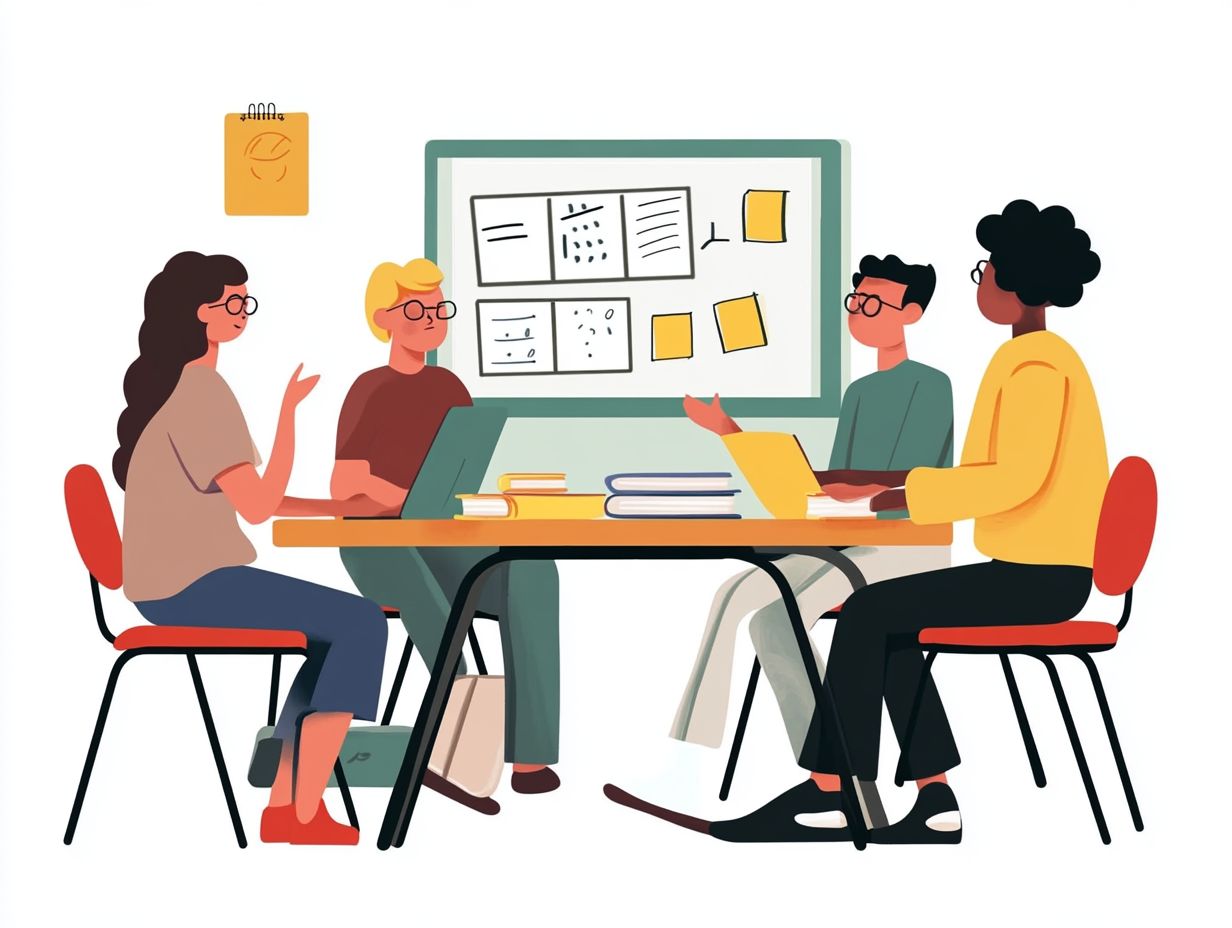
What are the top resources for learning sign language?
Some top resources include online courses, sign language dictionaries, educational books and DVDs, sign language apps, and local community classes.
Are online courses effective for learning sign language?
Yes, online courses provide interactive lessons, video demonstrations, and practice exercises that effectively teach sign language. They offer self-paced learning and flexibility in scheduling.
Can I learn sign language from a sign language dictionary?
A sign language dictionary can supplement your learning, but it is not recommended as the sole resource. A dictionary typically provides signs for individual words, while learning sign language requires understanding grammar, sentence structure, and context.
Want to know the best way to practice sign language?
The best way to practice is to interact regularly with fluent signers. Attend community classes, join a sign language club, or find a conversation partner. Also, practice on your own using resources like books, apps, or online courses.
Are there any free resources for learning sign language?
Yes, many free resources are available, including online courses, YouTube tutorials, and sign language dictionaries. Some local community centers or libraries may also offer free classes or resources.
Can I become fluent in sign language by using these top resources?
While these resources provide a strong foundation, becoming fluent requires consistent practice, immersion, and interaction with native signers. It s also beneficial to take formal classes or work with a tutor for advanced learning and practice.
